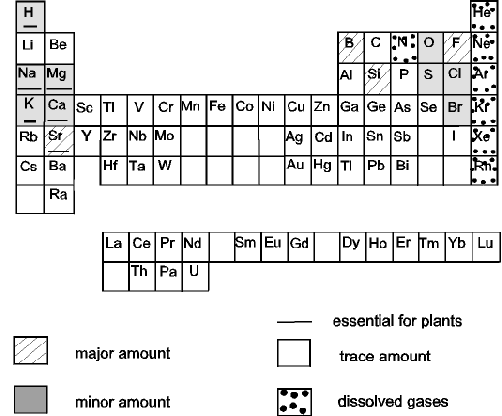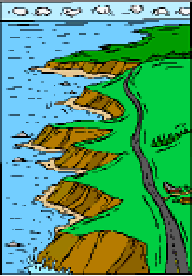POST LAB

Elements in seawater.
WORKSHEET
Here's a list of websites that are also useful in many subjects they my kids like to surf:
OBJECTIVES:(I highly recommend using a children's dictionary to go over vocabulary words so they clearly understand each word) MATERIALS: |
|

|
BACKGROUND: Why are the oceans so salty? Rain on land causes rivers to wash salt minerals from the land and carry them to the oceans. Rivers not only carry salts to the ocean but also many other elements. In fact, the oceans contain gold and silver! If you calculate how much salt there is in the ocean, there would be enough salt to give millions of boxes of salt to each person living in the United States. That's a lot of salt! Salt is a very important commodity to people around the world. Before refrigerators, people had to salt their food in order to preserve it. Salt is important for preserving food and organisms need a balance of salt in their bodies in order to stay healthy.
PROCEDURE:
- Compare the periodic table placemats with the elements that are in seawater figure. Students can then discover the components of salt water. Go over what each of the major constituent symbols including:
| Na = sodium Mg = magnesium K = potassium Ca = calcium H = hydrogen C = carbon O = oxygen S = sulfur Cl = chlorine Br = bromine. |

Elements in seawater.
- Use the worksheet to illustrate that salt water is made during the movement of water on land. The diagram shows areas where salt is added to the oceans by volcanoes, water erosion of the land, and evaporation of pure water which leaves the salts behind.
WORKSHEET
- Do clouds have salt in them?
Why?
- Are there any areas that have salt water other than the oceans?
Name them.
- Salt water is made during the movement of water on land. The diagram above shows areas where salt is added to the oceans. Label: evaporation, erosion, source of salts
Remember: the word "salt" does not just mean the kind of salt you eat!!
Don't worry if your student doesn't quite get these big concepts immediately, just go over each answer until they do understand and allow them to ask as many questions as is needed for them to understand. I find that utilizing the internet as a resource for more lessons like this help further expands their understanding. Also if you have boys like me (or girls) that love to learn and do research on the internet then allow them to do so with parental supervision then ask them specific questions about what they learned.
- ANSWERS:
- Clouds do not have salt in them. Only water can evaporate.
- Yes, large seas and old lakes have salt in them. Mediterranean Sea and Salt Lake are just a few. Students need to look at the globe.
- Sources of salt: volcano and land; evaporation is occurring over the water; erosion is occurring on land and in parts of the ocean that moves.
Here's a list of websites that are also useful in many subjects they my kids like to surf:
- MBGnet
- The Weather Channel Kids
- Weather Watch
- The Science Spot Kids Zone
- Learner/Interactives
- NOVA
- Weather WizKids
- Fun Brain
- Tree House Weather Kids
- Brain Pop Jr.
Jenna




















